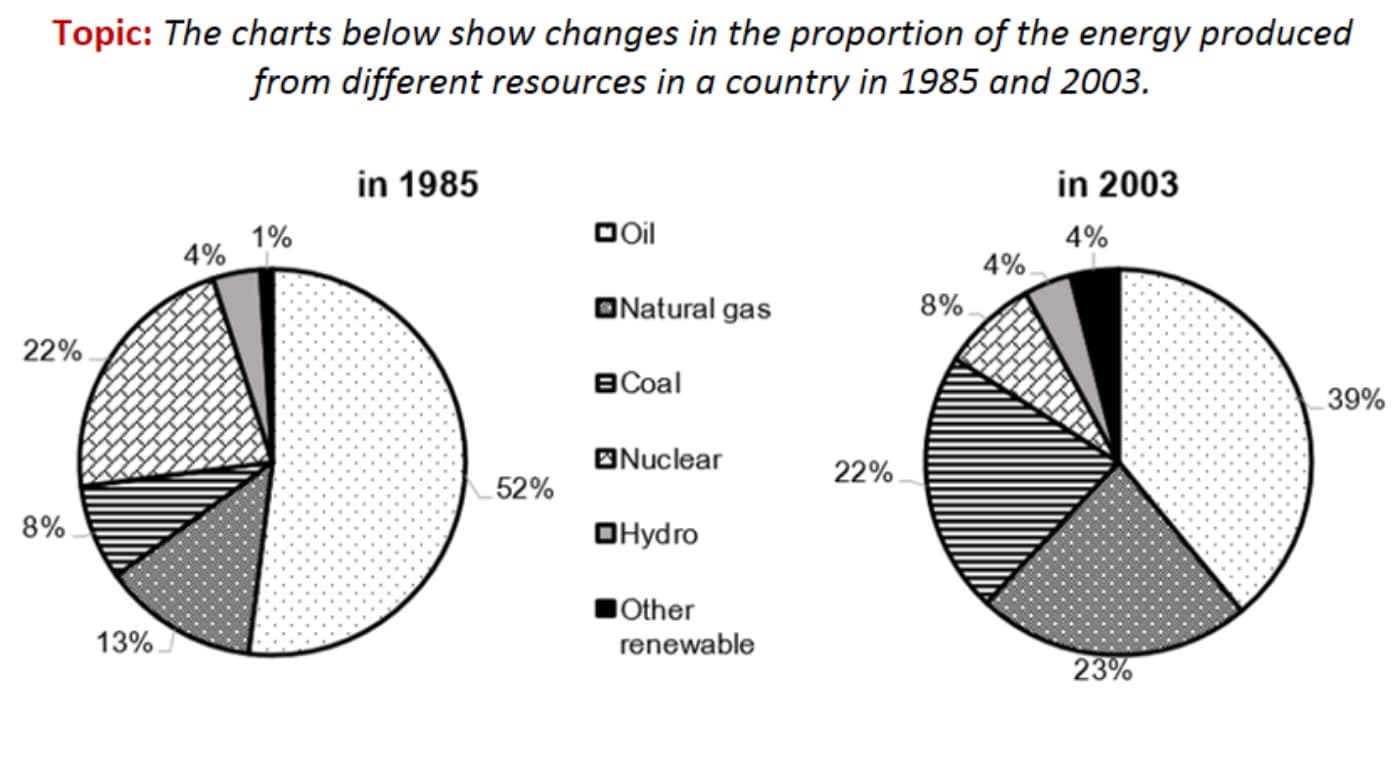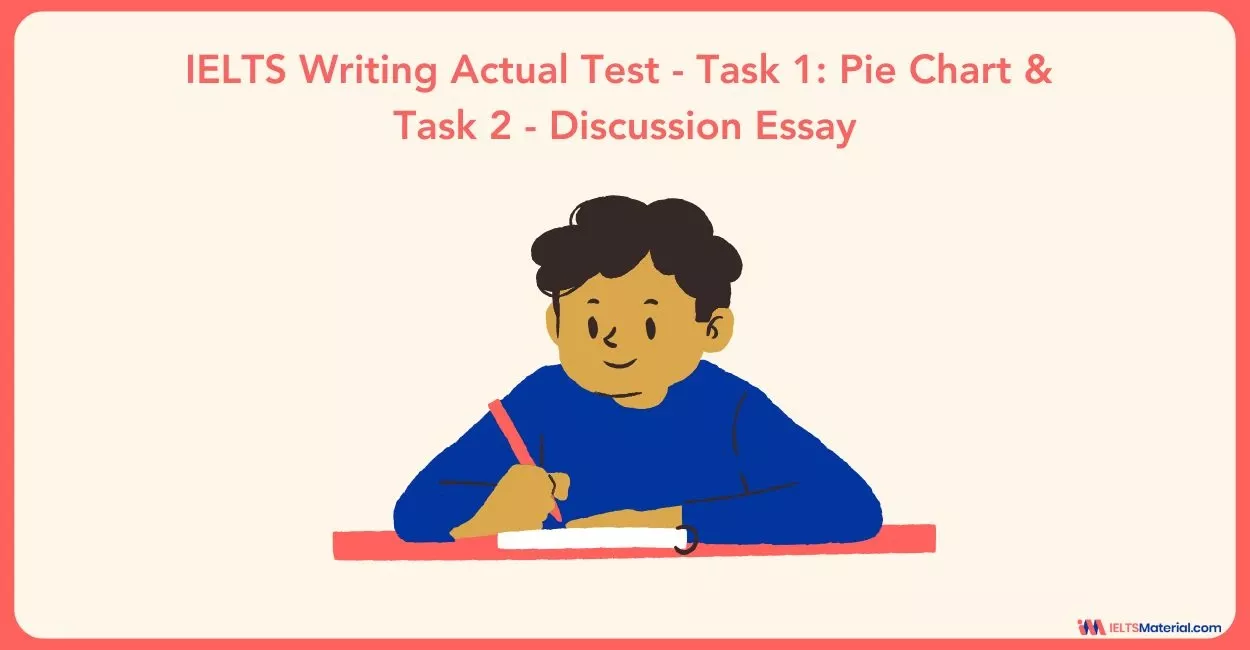IELTS Writing Actual Test - Task 1: Pie Chart & Task 2 - Discussion Essay
Get set to answer this IELTS Writing Actual Test - Task 1: Pie Chart & Task 2 - Discussion Essay. Find out the ways to answer the question types with our expert tricks as well to achieve a Band 7.0–8.0 score!
Table of Contents

Try AI Essay Checker for Instant Band Score
In the IELTS Writing tasks, you are assessed not only by your English proficiency but also by your ability to present ideas logically, compare data, and provide well-structured arguments. In this article, let us get ready to explore the IELTS Writing practice test, which includes Task 1 (Pie chart) and Task 2 (discussion essay).
Alongside the sample answers, we will also share useful topic-specific tips to help you improve your IELTS Writing band score.
Connect with our IELTS Trainers to crack your IELTS writing exam in no time! FREE Demo
Tricks to Frame a Band 9 IELTS Pie Chart Report
Introduction
-
Begin by paraphrasing the given task statement. This means to start restating the given information in your own words without ever changing the meaning.
Overview
- The overview is one of the most important parts of your answer. In this, you should be highlighting the main features of the given pie chart rather than explaining the details.
- Try mentioning the largest and smallest categories, any important differences, or overall changes if more than a single chart is presented.
Body Paragraphs
- Separate your details properly into two clear paragraphs.
- In the first body paragraph, try to describe the major categories (the largest parts or those that are standing out the most).
- Use the approximate figures or percentages if necessary, but try to avoid listing all numbers.
- In the next body paragraph, focus on the smaller categories and try to make comparisons where relevant. This balance makes sure that you cover all aspects of the given data without overwhelming the examiner.
Language Use
- Try using a wide range of expressions to describe percentages and comparisons.
- Instead of consistently repeating “percent,” you can vary your language with terms like “accounted for,” “represented,” or “comprised.”
- For comparisons, try using expressions such as “was twice as large as,” “slightly lower than,” or “just under.”
- This variety in language showcases strong vocabulary skills, which the examiners look out for in an ideal candidate.
Final Tips
- Do not try to describe every single percentage given.
- Focus on the given trends and relationships between the given categories.
- Aim for writing around 150–170 words to keep your writing concise yet specific enough.
- Always make sure to include an overview, because without it, your band score for Task Achievement will be limited.
Practice Question: IELTS Writing Task 1
You should spend 20 minutes on this task.
The charts below show changes in the proportion of the energy produced from different resources in a country in 1985 and 2003.
You should write at least 150 words.

Report Plan
Paraphrase: illustrate> depicts; comparison in energy generated from different sources; Name a few.
Overview/Summary paragraph: oil>dominant source; proportion dropped; Give figures for oil; Increase of energy production by other sources.
Paragraph 3: Rise in the energy production of natural gas, other renewable sources, and coal; Give figures
Paragraph 4: decrease in the production of nuclear energy and no change in hydro energy till the end of the period.
IELTS Writing Task 1: Sample Answer
The two pie charts illustrate the comparisons of energy generated from various sources, including oil, natural gas, hydro, nuclear, and other renewable sources, in a country between 1985 and 2003.
We can observe from the pie-charts that oil was still the most dominant source of energy production throughout the period despite its usage dramatically dropping from 52% in 1983 to approximately 39% in 2003. However, the country gradually increased energy production from coal, natural gas, and renewable sources.
Over the years, the percentage of natural gas witnessed an increase from 13% to 23%, and coal energy production moderately rose from 8% to 13% in the year 2003. Other renewable resources slightly increased their production from 1% to 4% over 18 years.
Meanwhile, the usage of nuclear energy saw a significant decline from 22% in 1985 to 17% in 2003. Interestingly, Hydro energy accounted for 4% in the initial year and remained stable until the end.
Practice Question: IELTS Writing Task 2
You should spend 40 minutes on this task.
Some people think that the increasing business and cultural contact between countries bring many positive developments. Others say it can cause the loss of national identities. Discuss both views and give your own opinions.
You should write at least 250 words.
IELTS Writing Task 2: Sample Answer
People have different views about the impacts of globalization. Although this development could exert positive influences on national economy, I am of great concern that the preservation of national identities would be deterred.
On the one hand, it is argued by many that cross-border economic and cultural cooperation could be the major drive of national growth. Firstly, increased international trade could create conditions for an economy to grow by leveraging their competitive advantages and boosting their export earnings. The benefit is best shown through robust economic development of net exporters like X country. With the elimination of economic barriers between countries,
X country, a hub of agricultural products, has earned a huge flow of foreign exchange by emerging as the second largest rice exporter worldwide. Improvement in people’s spiritual lives would also accompany. Besides that, borderless cultural contact means that people have chances to get exposed to foreign cultures, whose diversity could enable them to enrich their knowledge and have more choices of entertainment. The popularity of Korean and US – UK music products in Y country could exemplify this point.
On the other hand, I am more of the belief that the uniqueness of individual countries could be under threat as a consequence of growing international cooperation. Multinational corporations could put them in a position to influence local cultural values and promote Western ones in nations having their presence. This is because these Western ideologies could be easily assimilated into local cultures when Western-standard products are marketed and consumers familiarize themselves with new lifestyles these goods create. This might, in the long run, result in a homogeneous set of beliefs and values adopted and the erosion of cultural diversity worldwide.
In conclusion, it is irrefutable that globalization has backed economic and social developments in many countries. However, the danger of losing national identities is also obvious. To avoid such a consequence, I believe that nations need to take actions to preserve their cultural identity through proper education and bolstered social cohesion.
Get Better at Writing for IELTS with IELTSMaterial
Practising more tests, as well as different topics on pie charts, would be hugely beneficial for you! Talk to our IELTS experts if you are wondering how to succeed on the IELTS writing exam. Also, we're holding interactive webinars where you can learn tricks to ace the writing component of the IELTS test. Let us know how it helped you prepare by leaving a comment below!
Also check :
Explore IELTS Writing

Start Preparing for IELTS: Get Your 10-Day Study Plan Today!
Recent Articles
Haniya Yashfeen

Kasturika Samanta






Post your Comments